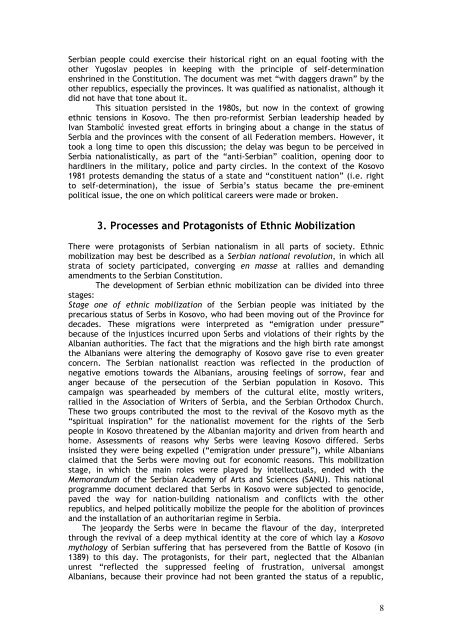Ethnic Mobilization in Serbia - EURAC
Ethnic Mobilization in Serbia - EURAC
Ethnic Mobilization in Serbia - EURAC
You also want an ePaper? Increase the reach of your titles
YUMPU automatically turns print PDFs into web optimized ePapers that Google loves.
<strong>Serbia</strong>n people could exercise their historical right on an equal foot<strong>in</strong>g with the<br />
other Yugoslav peoples <strong>in</strong> keep<strong>in</strong>g with the pr<strong>in</strong>ciple of self-determ<strong>in</strong>ation<br />
enshr<strong>in</strong>ed <strong>in</strong> the Constitution. The document was met “with daggers drawn” by the<br />
other republics, especially the prov<strong>in</strong>ces. It was qualified as nationalist, although it<br />
did not have that tone about it.<br />
This situation persisted <strong>in</strong> the 1980s, but now <strong>in</strong> the context of grow<strong>in</strong>g<br />
ethnic tensions <strong>in</strong> Kosovo. The then pro-reformist <strong>Serbia</strong>n leadership headed by<br />
Ivan Stambolić <strong>in</strong>vested great efforts <strong>in</strong> br<strong>in</strong>g<strong>in</strong>g about a change <strong>in</strong> the status of<br />
<strong>Serbia</strong> and the prov<strong>in</strong>ces with the consent of all Federation members. However, it<br />
took a long time to open this discussion; the delay was begun to be perceived <strong>in</strong><br />
<strong>Serbia</strong> nationalistically, as part of the “anti-<strong>Serbia</strong>n” coalition, open<strong>in</strong>g door to<br />
hardl<strong>in</strong>ers <strong>in</strong> the military, police and party circles. In the context of the Kosovo<br />
1981 protests demand<strong>in</strong>g the status of a state and “constituent nation” (i.e. right<br />
to self-determ<strong>in</strong>ation), the issue of <strong>Serbia</strong>’s status became the pre-em<strong>in</strong>ent<br />
political issue, the one on which political careers were made or broken.<br />
3. Processes and Protagonists of <strong>Ethnic</strong> <strong>Mobilization</strong><br />
There were protagonists of <strong>Serbia</strong>n nationalism <strong>in</strong> all parts of society. <strong>Ethnic</strong><br />
mobilization may best be described as a <strong>Serbia</strong>n national revolution, <strong>in</strong> which all<br />
strata of society participated, converg<strong>in</strong>g en masse at rallies and demand<strong>in</strong>g<br />
amendments to the <strong>Serbia</strong>n Constitution.<br />
The development of <strong>Serbia</strong>n ethnic mobilization can be divided <strong>in</strong>to three<br />
stages:<br />
Stage one of ethnic mobilization of the <strong>Serbia</strong>n people was <strong>in</strong>itiated by the<br />
precarious status of Serbs <strong>in</strong> Kosovo, who had been mov<strong>in</strong>g out of the Prov<strong>in</strong>ce for<br />
decades. These migrations were <strong>in</strong>terpreted as “emigration under pressure”<br />
because of the <strong>in</strong>justices <strong>in</strong>curred upon Serbs and violations of their rights by the<br />
Albanian authorities. The fact that the migrations and the high birth rate amongst<br />
the Albanians were alter<strong>in</strong>g the demography of Kosovo gave rise to even greater<br />
concern. The <strong>Serbia</strong>n nationalist reaction was reflected <strong>in</strong> the production of<br />
negative emotions towards the Albanians, arous<strong>in</strong>g feel<strong>in</strong>gs of sorrow, fear and<br />
anger because of the persecution of the <strong>Serbia</strong>n population <strong>in</strong> Kosovo. This<br />
campaign was spearheaded by members of the cultural elite, mostly writers,<br />
rallied <strong>in</strong> the Association of Writers of <strong>Serbia</strong>, and the <strong>Serbia</strong>n Orthodox Church.<br />
These two groups contributed the most to the revival of the Kosovo myth as the<br />
“spiritual <strong>in</strong>spiration” for the nationalist movement for the rights of the Serb<br />
people <strong>in</strong> Kosovo threatened by the Albanian majority and driven from hearth and<br />
home. Assessments of reasons why Serbs were leav<strong>in</strong>g Kosovo differed. Serbs<br />
<strong>in</strong>sisted they were be<strong>in</strong>g expelled (“emigration under pressure”), while Albanians<br />
claimed that the Serbs were mov<strong>in</strong>g out for economic reasons. This mobilization<br />
stage, <strong>in</strong> which the ma<strong>in</strong> roles were played by <strong>in</strong>tellectuals, ended with the<br />
Memorandum of the <strong>Serbia</strong>n Academy of Arts and Sciences (SANU). This national<br />
programme document declared that Serbs <strong>in</strong> Kosovo were subjected to genocide,<br />
paved the way for nation-build<strong>in</strong>g nationalism and conflicts with the other<br />
republics, and helped politically mobilize the people for the abolition of prov<strong>in</strong>ces<br />
and the <strong>in</strong>stallation of an authoritarian regime <strong>in</strong> <strong>Serbia</strong>.<br />
The jeopardy the Serbs were <strong>in</strong> became the flavour of the day, <strong>in</strong>terpreted<br />
through the revival of a deep mythical identity at the core of which lay a Kosovo<br />
mythology of <strong>Serbia</strong>n suffer<strong>in</strong>g that has persevered from the Battle of Kosovo (<strong>in</strong><br />
1389) to this day. The protagonists, for their part, neglected that the Albanian<br />
unrest “reflected the suppressed feel<strong>in</strong>g of frustration, universal amongst<br />
Albanians, because their prov<strong>in</strong>ce had not been granted the status of a republic,<br />
8

















